

Case Report - Year 2014 - Volume 29 -
Partial reconstruction of a nose based on a nasolabial flap after the resection of a squamous cell carcinoma involving the nasal septum, columella, and upper lip
Reconstrução parcial de nariz baseada em retalho nasogeniano após ressecção de carcinoma espinocelular envolvendo septo nasal, columela e lábio superior
ABSTRACT
INTRODUCTION: Reconstruction of complex facial defects is a challenge for surgeons. After the excision of a lesion, nasal reconstruction is challenging because of the variety of tissues involved and the reduced local donor area for reconstruction. On the other hand, a major difficulty in the reconstruction of lip lesions is restoration of function, with the priority being the maintenance of the integrity of the sphincter structure, oral continence, mouth opening, and sensitivity. Among the alternatives for the reconstruction of these areas are local flaps, including the nasolabial flap.
AIM: To analyze the outcome of nasal and upper lip reconstruction performed in two surgical stages, by using a nasolabial flap for complex defects resulting from the resection of squamous cell carcinoma (SCC).
CASE REPORT: A 56-year-old female patient presented with advanced SCC in the nasal region of the columella, anterior third of the septum, and part of the upper lip. She underwent reconstruction with a nasolabial flap and, in a second surgical procedure, with a costal cartilage graft for the reconstruction of the columella. The procedures resulted in good integration and viability of grafts and flaps. The aesthetic result was satisfactory.
CONCLUSION: The use of a nasolabial flap as a therapeutic option for the partial reconstruction of the nose and upper lip produces favorable functional and aesthetic outcomes. In addition, the division of the surgical procedure into stages provides safety in the use of local flaps, particularly in patients with poor healing.
Keywords: Nasal reconstruction; Squamous cell carcinoma; Nasolabial flap; Reconstructive surgery.
RESUMO
INTRODUÇÃO: Reconstruções de defeitos complexos na face constituem um desafio para os cirurgiões. Após ressecção da lesão, o reparo nasal é difícil, já que possui uma variedade de tecidos e área local doadora reduzida para reconstrução. Já as lesões de lábio possuem como principal dificuldade a restauração da função, priorizando a integridade da estrutura esfincteriana, a continência oral, a abertura bucal e a sensibilidade. Entre as alternativas para reconstrução dessas áreas, podemos optar por retalhos locais, entre os quais o nasogeniano.
OBJETIVO: Analisar desfechos de reconstrução nasal e de lábio superior em dois tempos cirúrgicos, utilizando retalho nasogeniano, após defeito complexo causado por ressecção de carcinoma espinocelular (CEC).
RELATO DO CASO: Paciente do gênero feminino, 56 anos, apresentou CEC de progressão avançada em região nasal da columela, terço anterior do septo e parte do lábio superior. A paciente foi submetida à reconstrução com retalho nasogeniano e, em segundo momento cirúrgico, ao enxerto de cartilagem costal para reconstrução de columela. Apresenta evolução com boa integração e viabilidade dos enxertos e retalhos. O resultado estético foi satisfatório.
CONCLUSÃO: A utilização de retalho nasogeniano como opção terapêutica para a reconstrução parcial de nariz e de lábio superior apresentou desfechos funcionais/estéticos favoráveis. Além disso, a segmentação do procedimento cirúrgico traz segurança na utilização dos retalhos locais, principalmente em indivíduos de difícil cicatrização.
Palavras-chave: Reconstrução nasal; Tumor espinocelular; Retalho nasogeniano; Cirurgia reconstrutiva.
Reconstruction of complex facial defects resulting from the surgical excision of skin tumors is a challenge for surgeons because of the functional and aesthetic changes involved1. Squamous cell cancer (SCC), also known as epidermoid carcinoma, is the second most common nonmelanoma skin cancer, accounting for 25% of all cases2. Seventy percent of SCCs occur in the neck and face, of which 30% occur in the nose and 25% in the lips3.
Considering only lip cancers, SCC is the most common cancer type. SCCs present slow growth and infrequent metastasis but can cause remarkable local destruction, hampering reconstruction4. The abundance of sebaceous glands, exposure to ultraviolet radiation A and B (UVA, UVB), fair skin tone, genodermatoses, chemical agents, and chronic skin lesions are the main factors that favor the development of this type of cancer. The primary treatment of this complex tumor is surgical resection3.
Reconstruction of the nose is often difficult because it consists of a variety of tissues and has reduced local donor area for the reconstruction5. Lip defects, on the other hand, present a major difficulty in restoring function, with the priority being the maintenance of the integrity of the sphincter structure, oral continence, mouth opening, and mouth sensitivity6. The aim of this report is to analyze the outcomes of a nasal and upper lip reconstruction performed in two surgical stages, by using a nasolabial flap (NLF) to correct complex defects caused by the resection of an SCC.
CASE REPORT
A 56-year-old female Caucasian patient was referred for the emergence of a small nodular lesion in the nasal columellar region about 1 year ago. Three months after the appearance, the wound began to fester, with serous discharge having a foul odor and progressive growth, for which biopsy was performed. The biopsy result revealed a well-differentiated (grade I), keratinized, and ulcerated SCC. Macroscopically, the lesion was about 4.0 × 5.0 cm in the larger dimensions, reddish, pedicled, ulcerated, with purulent discharge, and painful on palpation (Figure 1). On physical examination, there was an absence of lymphadenopathy in the cervical, axillary, or clavicular lymph node chains. Concerning the patient's background, she reported heavy smoking with 40 pack-years and chronic sun exposure. She denied having alcohol addiction.
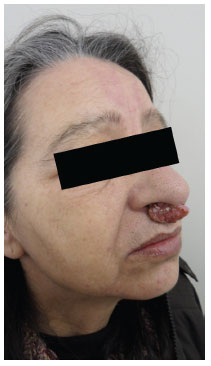
Figure 1. Photograph of the patient presenting with a squamous cell carcinoma involving the septal region, nasal columella, and upper lip.
Computed tomography of the face, after the administration of intravenous iodinated contrast, revealed an increase in thickness, irregularity, and heterogeneity next to the skin tissue in the topography of the nasal septum cartilage, at the right anteroinferior position, with enhancement after contrast administration. The anterosuperior portion of the nasal septum showed diversion to the left side. Other structures showed no peculiarities.
The tumor was classified as stage III, T4N0M0. The T4 staging was based on the invasion of extradermal structures such as cartilage, muscle, and bone. Total excision was performed, with free margins during surgical freezing. At the same time, reconstruction of the nasal columella and upper lip was performed with an NLF based on a superior pedicle. Figures 2 and 3 show images of the intraoperative procedure. After the final results from the pathological examination, a costal cartilage graft in the nasal columella region was implemented in a second intervention, increasing the projection of the nasal tip. The patient presented a good integration and viability of grafts and flaps. The aesthetic and functional results were satisfactory. Figure 4 (frontal view) and Figure 5 (profile) show the result on the 30th day after surgery. The patient allowed the publication of this case report, including her pictures, by signing an informed consent form.
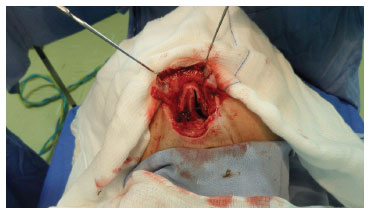
Figure 2. Intraoperative aspect after the resection of a squamous cell carcinoma in the septal region, nasal columella, and upper lip, revealing the nasal cartilaginous structures.
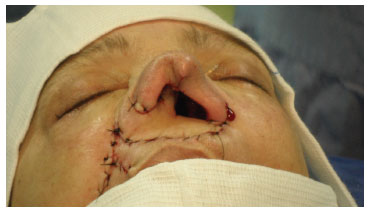
Figure 3. Immediate postoperative aspect of the nasal reconstruction based on a superiorly pedicled nasolabial flap.
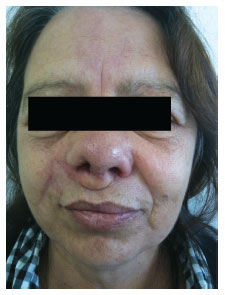
Figure 4. Postoperative results of nasal reconstruction based on a nasolabial flap, with placement, at a second surgical stage, of a costal graft in the columellar region. The image was taken 30 days after the second surgery.
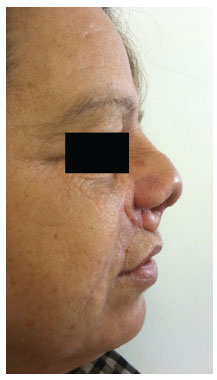
Figure 5. Postoperative results of nasal reconstruction based on a nasolabial flap, with placement, at a second surgical stage, of a costal graft in the columellar region. The image was taken 30 days after the second surgery. Portrait in profile.
DISCUSSION
After achieving the primary goal of curative resection of a lesion, reconstruction of the resulting complex facial defects require broad knowledge and the use of surgical techniques to ensure good functional and aesthetic outcomes. Menick7 reviewed nasal reconstruction techniques, considering the use of costal cartilage for the nasal cartilaginous framework.
In this case, reconstruction was done with a superiorly pedicled NLF, which, to the authors, seems an appropriate choice, taking into account the conservation of the orbicularis oris muscle. From then the difficulties in reconstructing the nasal pyramid overlap. The columella, right nasal portion, nasal floors, cartilage of the nasal tip and septum, and distal triangular cartilage were resected, which limited the local tissue choices for reconstruction. Parrett & Pribaz 8 proposed an algorithm for the treatment of nasal lesions, by using local flaps for smaller defects and considering the possibility of reconstruction in stages. Some authors9,10 consider the use of local flaps but warn of the possibility of complications in cases of problematic healing; they do not, however, consider the possibility of performing the surgery in stages.
In our case, we chose reconstruction with local tissue in two stages. The NLF was used to construct the columella and part of the right ala. The nasal floors were repaired with mucosal flaps. The reconstruction of the cartilaginous pyramid was postponed for a second surgical procedure.
Two factors motivated the choice, the first being the clinical features of the patient. A failure, even in part, at any step in the coverage with local flaps, would most likely lead to an exposure and extrusion of the supporting material of the nasal pyramid. The second reason was that part of the nasal pyramid structure was preserved. Only the secondary goal of aesthetic setting would remain, adapting to functionality.
The second surgical stage was done through use of a costal cartilage. Elongation of the nasal pyramid, definition and projection of the columella, and projection and structuring of the nasal tip were performed. The good performance of the first surgical stage provided assurance for a second stage. The success of the first stage was essential to the viability of the reconstruction of the nasal pyramid. Repair in two stages seems useful in patients with complex defects (extended resections) and clinical characteristics that involve difficulty in healing.
CONCLUSION
The use of NLF as a therapeutic option for partial reconstruction of the nose and upper lip offers favorable functional and aesthetic outcomes. In addition, the segmentation of the surgical procedure provides safety in the use of local flaps, particularly in patients with poor healing.
REFERENCES
1. El-Marakby HH. The versatile naso-labial flaps in facial reconstruction. J Egypt Natl Cancer Inst. 2005;17(4):245-50. PMid:17102819.
2. Instituto Nacional de Câncer José Alencar Gomes da Silva - INCA. Câncer de Pele - Não Melanoma [Internet]. Rio de Janeiro: INCA; 2011 [cited 2011 Mar 12]. Available from: http://www.inca.gov.br/conteudo_view.asp?id=334.
3. Moolenburgh SE, McLennan L, Levendag PC, Munte K, Scholtemeijer M, Hofer SO, et al. Nasal reconstruction after malignant tumor resection: an algorithm for treatment. Plast Reconstr Surg. 2010;126(1):97-105. PMid:20220560.
4. Simas NG, Pessoa SGP, Crisóstomo MR, Almeida GS, Gomes AAR. Uso de retalho septal e pericondro mucoso para reconstrução de asa nasal e parede lateral: relato de caso. Rev Bras Cir Plást. 2009;24(4):556-8.
5. Mélega JM. Cirurgia plástica: fundamentos e arte: cirurgia reparadora de cabeça e pescoço. Rio de Janeiro: Medsi; 2002.
6. Sbalchiero JC, Anlicoara R, Cammarota MC, Leal PRA. Reconstrução labial: abordagem funcional e estética após ressecção tumoral. Rev Bras Cir Plást. 2005;20(1):40-5.
7. Menick FJ. Nasal reconstruction. Plast Reconstr Surg. 2010;125(4):138e-50e. http://dx.doi.org/10.1097/PRS.0b013e3181d0ae2b. PMid:20335833
8. Parrett BM, Pribaz JJ. An algorithm for treatment of nasal defects. Clin Plast Surg. 2009;36(3):407-20. http://dx.doi.org/10.1016/j.cps.2009.02.004. PMid:19505611
9. Asaria J, Pepper JP, Baker SR. Key issues in nasal reconstruction. Curr Opin Otolaryngol Head Neck Surg. 2010;18(4):278-82. http://dx.doi.org/10.1097/MOO.0b013e32833af8f8. PMid:20485171
10. Collar RM, Ward PD, Baker SR. Reconstructive perspectives of cutaneous defects involving the nasal tip: a retrospective review. Arch Facial Plast Surg. 2011;13(2):91-6. http://dx.doi.org/10.1001/archfacial.2011.13. PMid:21422442
1. MSc, Pontifícia Universidade Católica (PUC-RS), Plastic Surgeon, Member of the Brazilian Society of Plastic Surgery (SBCP), Tutor of the Plastic Surgery Service, Hospital Geral de Caxias do Sul of the Universidade de Caxias do Sul (UCS), Professor, Surgical Techniques and Surgical Propedeutics, Caxias do Sul, RS, Brazil
2. Plastic Surgeon, Member of the Brazilian Society of Plastic Surgery (SBCP), Tutor of the Plastic Surgery Service, Hospital Geral de Caxias do Sul of the Universidade de Caxias do Sul (UCS), Caxias do Sul, RS, Brazil
3. Medical Student, Member of the Liga de Cirurgia Plástica, Universidade de Caxias do Sul (UCS), Caxias do Sul, RS, Brazil
Institution: Work performed by the LACP (Liga Acadêmica de Cirurgia Plástica) together with the Plastic Surgery Service, Hospital Geral de Caxias do Sul, Universidade de Caxias do Sul, RS, Brazil.
Corresponding author:
Anderson Ricardo Ingracio
Rua General Arcy da Rocha Nóbrega, 401, Room 605 - Madureira
Caxias do Sul, RS, Brazil
Fax: (54) 3208-3936
E-mail: andersoning@hotmail.com
Article received: June 13, 2011.
Article accepted: August 13, 2011.


 Read in Portuguese
Read in Portuguese
 Read in English
Read in English
 PDF PT
PDF PT
 Print
Print
 Send this article by email
Send this article by email
 How to Cite
How to Cite
 Mendeley
Mendeley
 Pocket
Pocket
 Twitter
Twitter